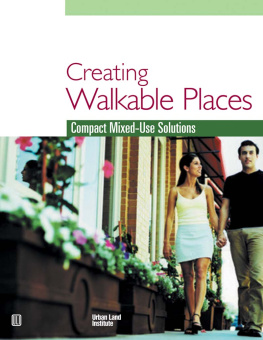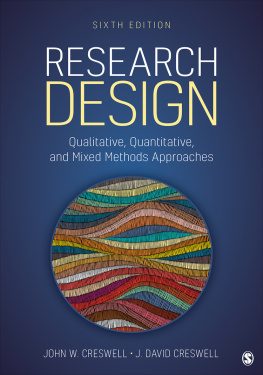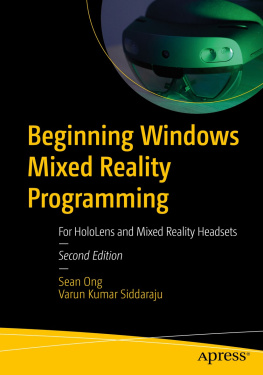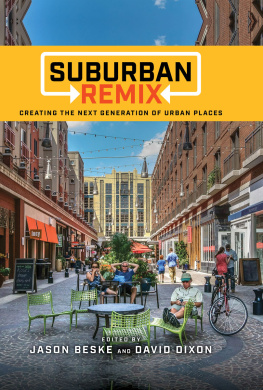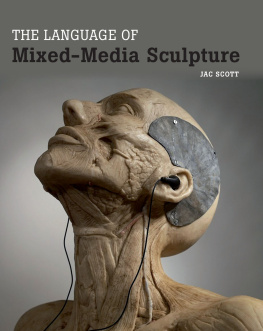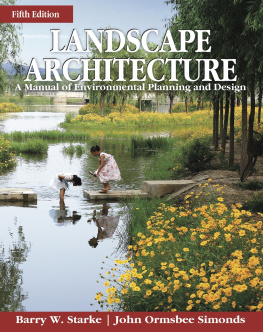
Copyright 2006 by ULI-the Urban Land Institute
All rights reserved. No part of this book may be reproduced in any form or by any means, electronic or mechanical, including photocopying and recording, or by any information storage and retrieval system, without written permission of the publisher.
ULI-the Urban Land Institute
1025 Thomas Jefferson Street, N.W.
Suite 500 West
Washington, D.C. 20007-5201
Library of Congress Cataloging-in-Publication Data
Schmitz, Adrienne.
Creating walkable places : compact mixed-use solutions / Adrienne Schmitz and Jason Scully.
p. cm.
ISBN-13: 978-0-87420-938-9 (alk. paper) 1. City planningUnited States. 2. City planningHealth aspectsUnited States. 3. Pedestrian areasUnited States. 4. Real estate developmentUnited States. 5. Mixed-use developmentsUnited StatesCase studies. I. Scully, Jason. II. Urban Land Institute. III. Title.
HT167.S264 2006
307.12160973dc22
2006029466
10 9 8 7 6 5 4 3 2 1
Printed in the United States of America.
About ULI
ULI-the Urban Land Institute is a nonprofit education and research institute that is supported by its members. Its mission is to provide responsible leadership in the use of land to enhance the total environment. ULI sponsors education programs and forums to encourage an open, international exchange of ideas and sharing of experiences; initiates research that anticipates emerging land use trends and issues and documents best practices; proposes creative solutions based on that research; provides advisory services; and publishes a wide variety of materials to disseminate information on land use and development. Established in 1936, ULI has more than 28,000 members in 80 countries representing the entire spectrum of the land use and development disciplines.
Project Staff
Rachelle L. Levitt
Executive Vice President, Policy and Practice
Gayle Berens
Vice President, Real Estate Development Practice
Adrienne Schmitz
Director, Residential Community Development
Project Director and Author
Jason Scully
Senior Associate, Policy and Practice Author
Nancy H. Stewart
Director, Book Program Managing Editor
Sandra F. Chizinsky
Manuscript Editor
Betsy VanBuskirk
Art Director
Byron Holly
Book Design and Layout Senior Designer
Karrie Underwood
Digital Images Manager
Craig Chapman
Director, Publishing Operations
Principal Authors
Adrienne Schmitz and Jason Scully
Urban Land Institute Washington, D.C.
Contributing Authors
Steven Bodzin
Writer
San Francisco, California
Robert Dunphy
Senior Fellow Urban Land Institute Washington, D.C.
Claire Enlow
Writer
Seattle, Washington
Steven Fader
Principal
Steven Fader Architects Los Angeles, California
Laura Million
Writer
Franklin, Wisconsin
Sam Newberg
Market Research Analyst
Dahlgren, Shardlow, & Uban, Inc.
Minneapolis, Minnesota
Andrew Overbeck
Writer
Columbus, Ohio
Erinn Dowling Torres
Project Manager
George Washington University
Washington, D.C.
Reviewers
Robert Dunphy
Senior Fellow
Urban Land Institute
Washington, D.C.
Helen Hatch
Senior Principal
Thompson, Ventulett, Stainback, & Associates
Atlanta, Georgia
Christopher Leinberger
Founding Partner Arcadia Land Company Albuquerque, New Mexico
Arthur Lomenick
Managing Director
Trammell Crow Company
Dallas, Texas
Anne Vernez Moudon
Professor
Department of Urban Design and Planning, University of Washington
Seattle, Washington
Marilee Utter
President
Citiventure Associates LLC
Denver, Colorado
Preface
R eal estate development has a major influence on everyones life. Real estate developers create peoples homes, neighborhoods, and places of commerce and recreation, all of which determine how they live day to day. One aspect of how people live has been drawing increasing attention in recent years: how development patterns affect peoples health.
Public health experts have been making the case for more pedestrian-friendly development as a means of enabling people to integrate physical activity into their daily lives. It is a fact that people walk and bike for transportation much less than they used to. It is also a fact that Americans are increasingly overweight. Certainly, overeating is part of the problem, but lack of exercise is a contributing factor.
Many people would lead more active lives if they could, but their environments prevent them from doing so. Most development gives paramount importance to vehicle access, and little or no consideration to pedestrian accommodations. Land uses are separated, distances are large, and sidewalks are inaccessible or missing altogether.
What we hope to accomplish with this book is to show that there are alternatives to the status quo, and that many people want such alternatives. Developers can create more pedestrian-friendly places, and in so doing can improve their bottom line. Among the components of pedestrian-friendly places are mixed land uses; more and better sidewalks and trails; safer, slower traffic; and more accessible and convenient public transit.
In some places, things are already moving in the right direction. The nine case studies in this book show how forward-thinking developers and designers are finding ways to accommodate pedestrians, giving their projects wider appeal and generating great success. More and more examples can be cited, in both urban and suburban areas, that integrate transit, walking, and biking into the transportation networks. Some are new construction; others are redevelopments. Many of these creative solutions are discussed here, and new ones are breaking ground every day.
In the same way that activists worked together to curb smoking and drunk driving, concerned individuals and organizations are now tackling obesity. The Robert Wood Johnson Foundation, which made significant inroads in the war on tobacco, is spearheading the effort. The foundation is spending $70 million over a five-year period on studies and programs to encourage more active lifestyles as a means of stemming obesity and the diseases it causes. In its outside-the-box style, the foundation sees real estate development and land use patterns as a critical piece of the puzzle.
A final note: while this book was in the final stages of development, various studies came out disputing the link between sprawling development patterns and obesity. We acknowledge these studies and realize that there is ongoing controversy. That is the nature of research. But creating environments where people have choices, where walking and biking are viable pieces of the transportation network, is nevertheless an important goal. Any healthy environment must give people choices about the kinds of neighborhoods and homes they inhabit, and about how they get to school, to work, and to the neighborhood park.
Next page
